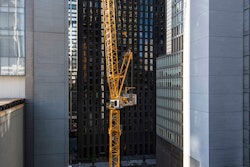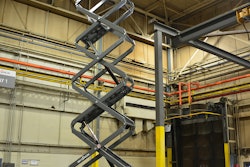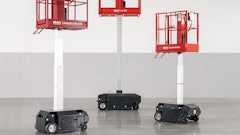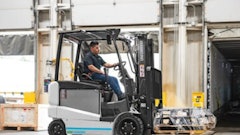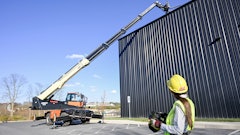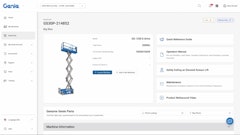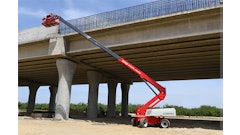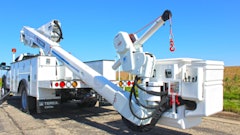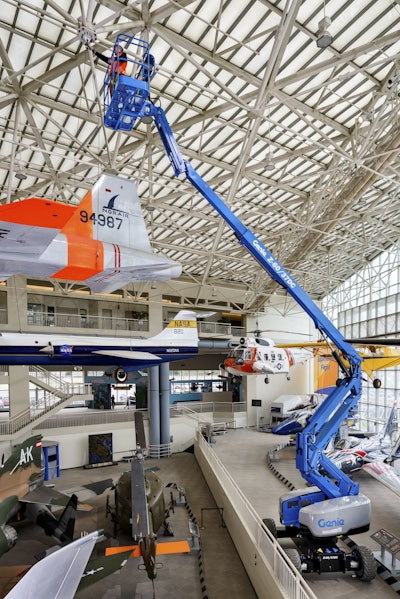
The aerial work platform (AWP) segment of the U.S. rental industry remains healthy and growing in 2016 - thanks to continued, although modest, growth in construction - but is expanding at a slower pace from recent years due to an expected cooling of fleet expansion within the replacement cycle.
As we enter the active rental season of 2016, many industry stakeholders are using the phrase "cautious enthusiasm" to describe their sentiment regarding the way they see the year playing out.
"We see a lot of positive momentum going on in non-residential construction and residential construction, but then, we also hear from our major customers a bit of caution," says Corey Raymo, category director for booms at JLG Industries. "They are in a bit of wait and see mode and are cautiously optimistic at this point."
According to data from Ducker Worldwide for the International Powered Access Federation (IPAF), aerial work platform rental revenues for 2016 are predicted to be $8.624 million, showing growth of 4 percent over 2015 revenues which came in at $8.292 million. In 2017, the forecast shows AWP rental revenues growing a bit more slowly at 3 percent to reach $8.917 million, with slow fleet expansion continuing at least through the year. The sector is not quite as robust as the rental market itself, which is predicted to show 6.6-percent growth in 2016, down slightly from 2015 growth of 6.9 percent.
Slowing fleet expansion is evidenced by reports from some of the largest rental chains, which are reporting plans for reduced capital expenditures for the year. United Rentals, for example, recently said it planned to spend less than half the CAPEX it spent in last year’s first quarter and would evaluate its plans for the year going forward.
The American Rental Association reported in February that rental penetration actually decreased slightly in 2015 to 53 percent from 54 percent in 2014. The ARA's Rental Penetration Index measures the amount of actual rented equipment active in the total equipment fleet. IHS Global Insight says the drop in the index in 2015 was because construction markets were hot, while energy markets were not. Equipment required for shale oil exploration was no longer in demand, but much of this equipment was well suited to construction, so rental companies that supply to both industries deferred some purchases of new equipment from construction sites and redeployed existing assets from energy to construction. In short, reduction in rental penetration reflects the slower rate at which rental companies added fleet.
One of the key factors contributing to slower fleet expansion is what some are referring to as the "replacement phenomenon."
According to Frank Nerenhausen, president of JLG Industries, the "replacement phenomenon" is a result of 2009 and 2010 being low years for the industry during the Great Recession. "As we move into this normal, average, seven-year replacement cycle, you’re replacing a smaller batch of machines that were purchased during that time. That’s what we’re dealing with, that’s what we planned for, and that’s what we’re seeing play out."
Still, Nerenhausen says JLG is happy with its growth. "We’re really encouraged by how we’ve left the first quarter - we've seen solid orders," he says. "That gives us confidence that the year is playing out to our expectations."
He adds, "We’re anticipating 2016 to be down from 2015, and not really because of fundamentals in the market or the health of the rental industry, but more so from a replacement demand standpoint. From a customer perspective, we continue to hear optimism about the market, maybe sometimes tempered optimism, but fundamentally, it looks like good, modest growth in the rental space."
Matt Fearon, president of Terex AWP, makers of Genie products, agrees. "In a recent earnings report, we said we'd be down 15 percent this year. That's driven mostly by the North American market for Genie. But there are other global markets that are flat. The only two that are really rising are Europe and China. The North American market is starting to slow down... from a manufacturer's perspective (that's a key point). Part of it is because of the cyclical replacement of fleet. Rental companies are starting to replace those 2008, 2009 and 2010 populations of machines and they just don't have a lot of them. They didn't buy much during those years. And building their fleets back up from those years is what's been driving the industry growth for the past few years, so we see that naturally coming down."
To Brad Boehler, president of Skyjack, it all still translates into growth. "My view is that while certain companies will be replacing, we are essentially in a growth phase," he says. "Looking at the top rental companies globally, fleet size is growing."
He adds, "US Construction (non-res) starts in January 2016 were up 13 percent over 2015 and North American rental utilization for the last quarter of 2015 showed scissors at 70.0 percent, telescopic booms at 70.4 percent, articulating booms at 68.7 percent and telehandlers at 76.7 percent. Add to this an impending ANSI standard change in 2017 which could potentially drive purchasing at the latter end of the 2016. I would say the outlook is positive."
He continues, "In the first two months of the year we witnessed this positivity in market growth and while January was a bit slower than expected, February more than made up for this."
Construction holding its own
Forecasts for construction have been generally positive for 2016, although like rental, somewhat tempered from earlier predictions.
"Construction is still good. Look at the indicators, they're still healthy," says Fearon. "Residential and nonresidential construction forecasts are positive, but from a manufacturer's perspective, we're going to feel that dip. It is not 2009, I keep telling everybody that. This is a dip that we anticipated. We've been looking at our forecast models, knowing that it's coming. In my opinion, the decline in oil prices in North America did throw a curve ball at the North American rental companies. They had to take that fleet out and move it around so their utilization dipped, and they're really watching their metrics. As much as you'd love to have growth every year, I love it that the rental companies are paying such close attention to how their fleet is being utilized. The industry is still healthy. A lot of people want to overreact and say that it could be getting worse than it is. We're not doom and gloom. We've been through the cycles before and we realize you can't just sit back. You've got to make the move when you get into these little troughs. It's not a major reset."
Nerenhausen agrees, noting that residential construction still has a lot of room for growth. "It’s made good recovery but it’s still not where I would consider it a healthy market, and non-res is doing well, and still has room to grow. Those basic fundamentals seem fairly positive for the future. That keeps us optimistic, but cautiously so."
The oil and gas effect
Oil and gas have certainly been the buzzwords for the past year, and the topic of how the recent slow down in North American drilling has affected the rental market is one everyone seems to enjoy delving into.
"I think oil and gas has had an impact, but it's more like a multiplier effect," says John Garrison, CEO of Terex. "It wasn't just the equipment at the well head that was affected. When you go out from the well head you see a lot of infrastructure, construction and a need for schools and hospitals that blossomed out from the well head, or from the fracking site. The multiplier effect caught us a little off guard, and that's now working its way through the system. Everybody's adjusting to that. It was a very good market for a very long period of time. It came down abruptly and that's hard, but we're working our way through it, and so are our customers. I think it will stabilize. There's also the other side of the equation... there's got to be some benefit to gas being only $1.50 per gallon. It helps the rental industry. I think it's going to help us all in the long run. It will take some time to generate back into the market. When will it transcend into buying habits? That's the big question, but I think it will happen."
Boehler agrees. "Some commentators have portrayed oil prices as a cloud on the horizon. Personally I'm not sure it's that simple. In certain areas there is no doubt this will have an impact on local economies. In those areas there may well be decreased rental demand, but oil industry facilities, even if wound down, will require maintenance. Further, this equipment is generally not oil patch specific and can be diverted to other markets. Nationally, I think that the oil issue will be at worst a wash and will likely even give some benefit as reduced fuel costs will decrease delivery overheads, and also drive consumer confidence and mega construction projects long term, hopefully improving rental revenue and margins. In time, that may lead to improved equipment demand for OEMs."
Equipment trends
When walking around The Rental Show, it was clear AWP manufacturers are focusing on hybrids and multi-fuel machines.
"I think we’re reaching an inflection point in the industry that’s going to bring more adoption of hybrid products," says Raymo at JLG. "There are regulations that drive it. construction sites that require noise-free machines, low-emission products, etc., and then there’s just the green impact. Customers are becoming more aware of the green impact."
He continues, "For as long as I can remember, purchase price has been the main negotiating point, but our customers are becoming a lot more aware of their costs from a total cost of ownership perspective. It's not just acquisition; they're thinking more and more about the service costs, warranty costs, the resale value, the uptime... all of that over the life of the product. They’re becoming more and more interested and aware that the purchase price is a much smaller component of the entire cost. That can drive design."
For its part, Skyjack is focusing on meeting the upcoming changes to ANSI standards for machine controls, which go into effect in 2017, and also on platform capacities, says Boehler, noting that there could be a need to increase these where possible. "The main reason is the increased demand for accessory products such as pipe racks, etc.," he says. "The dual-capacity rating on our later boom products is witness to this. Skyjack has also launched its Accessoryzer brand with this in mind and I am sure we will see more in this area."
Future predictions
Where does the AWP market go from here?
"Customer feedback and one or two significant players going through reorganization means there may well be a shift into calendar Q2, but again the sentiment is essentially positive," Boehler says. "Secondly, the new ANSI standard mentioned earlier may potentially drive purchasing at the latter end of the 2016."
Nerenhausen adds, "Oil and gas is bearing down on the psychology of folks. But you talk to people in different end markets and the amount of construction work that’s going to open up in the next 60 to 90 days is big. And these are multi-year projects. You piece enough of those together and you get a sense of optimism for the next several years. It’s good to see that companies, our customers, are very good operators and the oil and gas impact, the redistribution, is largely behind them, which is good. So now, we're just waiting for the construction season to see how the rest of the year plays out."




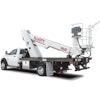
![[Video] 'Leaked' Footage of Genie Magnetic Scissor Lift Testing](https://img.forconstructionpros.com/files/base/acbm/fcp/image/2016/04/default.56fe8a1d0b77a.png?auto=format%2Ccompress&fit=crop&h=167&q=70&w=250)
